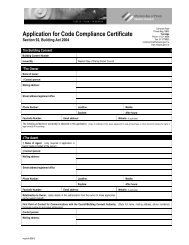7. low vines & scramblers - Western Bay of Plenty District Council
7. low vines & scramblers - Western Bay of Plenty District Council
7. low vines & scramblers - Western Bay of Plenty District Council
You also want an ePaper? Increase the reach of your titles
YUMPU automatically turns print PDFs into web optimized ePapers that Google loves.
<strong>7.</strong> LOW VINES & SCRAMBLERSBlackberryBlackberry smothers native shrubs and suppresses native re-establishment alongforest margins. It also smothers fences and over time the force that Blackberryexerts on the fences will damage them. It is normally controlled by spraying, butsmall plants can be dug out with the roots. A triclopyr based herbicide (e.g. Tordonor Grazon) will prove more effective than a glyphosate based herbicide (e.g.Roundup) for destroying Blackberry. Herbicides which contain the active ingredient<strong>of</strong> metsulfuron (e.g. Escort or Answer) are also very effective against Blackberry butcan kill adjacent native plants by ground translocation; furthermore, this herbicide isharmful to aquatic species so it should not be used near natural water bodies.Blue Morning GloryBlue Morning Glory is a tall and very fast growing growing, twining creeper withdistinctive heart-shaped, 3-lobed leaves and purple tubular f<strong>low</strong>ers all year round. Itprefers full sun but will tolerate light shade. This plant grows both in wet & dryconditions within open areas and along forest margins, roadsides, hedges andgardens. It is frost-tender and spreads vegetatively from stem fragments but doesn’tusually seed in NZ. Blue Morning Glory smothers native vegetation either as agroundcover or as a climber. This pest plant is controlled by hand pulling smallinfestations and removing all stem fragments from the site. Cut <strong>vines</strong> and largerstems at waist height & spray areas be<strong>low</strong> this in the summer-autumn period using100ml glyphosate + 20mls penetrant /10 litres <strong>of</strong> water or 2g metsulfuron +10mlpenetrant /10 litres <strong>of</strong> water.
BougainvilleaBougainvilleaThis is generally a deciduous yet vigorous climber with arching thorn-bearing canesand with pink, red or purple f<strong>low</strong>er bracts that have cream centres. This is acommon garden ornamental plant but without maintenance Bougainvillea can climbup to around 5m high smothering other plants. Control is achieved by fol<strong>low</strong>ing thecanes back to the main stem and cutting it at the base then immediately swabbingthe stump with glyphosate.Climbing AsparagusClimbing Asparagus is a fine leafed, dense smothering vine has small dark berriesand has minute hooks on the vine stems. It has been commonly grown in NewZealand as an indoor pot-plant and has escaped into the wild by dumping <strong>of</strong> greenwastethen subsequent spread and bird dispersal. It thrives in a wide range <strong>of</strong> lightand moisture conditions and spreads from seed dispersal, and by climbing over othervegetation. Small infestations can be controlled by cutting the plants back andcarefully digging out all the roots and the tubers; then the waste must be dried andburnt or disposed at a proper landfill but not in a green-waste collection. Largeinfestations are best controlled in spring or summer by cutting the <strong>vines</strong> about half ametre above ground and spraying the foliage remaining on the stump withglyphosate (e.g. Roundup) with a wetting agent such as Pulse penetrant added.Seedlings will need to be controlled until the tubers and soil seed-bank areexhausted.
Japanese HoneysuckleJapanese Honeysuckle is a rambling vine with large yel<strong>low</strong>/white f<strong>low</strong>ering massingheads. It is <strong>of</strong>ten seen engulfing road boundary fences and hedges, but when itestablishes within native bush the <strong>vines</strong> climb up into the tree canopy then thefoliage smothers the trees. Small areas <strong>of</strong> Japanese Honeysuckle can be blanketsprayed with glyphosate (e.g. Roundup) or triclopyr (e.g. Tordon) herbicides with awetting agent. Thick <strong>vines</strong> and larger infestations are best destroyed by cutting the<strong>vines</strong> about 100mm above ground then immediately swabbing the top <strong>of</strong> the cutstump and the remaining stem to ground level with Tordon, Grazon, or Vigilant Gel.Mile-a-Minute VineMile-a-Minute Vine is a vigorous ground-cover and climber with waxy, arrowheadshaped leaves 40-50mm long and small pink/purple pea-like f<strong>low</strong>ers. It forms densemats and smothers other plants. When this plant pest is growing as a largeinfestation it is best controlled by foliar spraying with a triclopyr based herbicide suchas Tordon or Grazon with a wetting agent (e.g. Pulse), taking care not to overspraydesirable plants. Small patches can be controlled by cutting the stems near groundlevel and immediately swabbing the base with Vigilant Gel or glyphosate (e.g.Roundup), while isolated plants may simply be dug up or seedlings pulled.Periwinkle (Vinca Major)Periwinkle is a dense mat-forming ground cover herb which can also creep over <strong>low</strong>growing native vegetation up to a metre high. It has dark green glossy oval shapedleaves and cream-mauve coloured f<strong>low</strong>ers which are flat with five petals. Control
Periwinkle by spraying Activated Amitrole or Glyphosate (e.g. Roundup) at200ml/10litres water plus 20mls Pulse penetrant. Periwinkle is difficult to controlwith herbicide so good spray coverage and the use <strong>of</strong> a wetting agent is essential.As Periwinkle may be growing over native plants care may be required to minimiseby-kill <strong>of</strong> desirable species.SmilaxSmilax is an emerald green leafed, white/pale green f<strong>low</strong>ering and red berriedscrambling vine which is now common in the <strong>Bay</strong> <strong>of</strong> <strong>Plenty</strong>. It originally escapedfrom home gardens and is now spread by bird dispersal <strong>of</strong> the seeds, by humandumping if greenwaste, and by root spreading. It typically grows densely,smothering the forest floor and shrubs up to three metres high. Smilax has strongroots and even small plants can be difficult to pull out. Small infestations can be dugout but large infestations are best controlled in the cooler growing months by cuttingthe <strong>vines</strong> about half a metre above ground and spraying the foliage remaining on thestump with glyphosate (e.g. Roundup) with a wetting agent such as Pulse penetrantadded. Seedlings will need to be controlled until the soil seed-bank is exhausted.
















